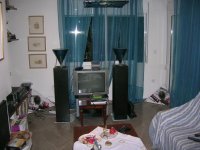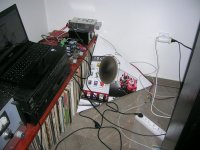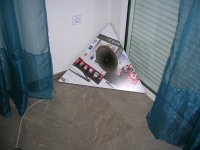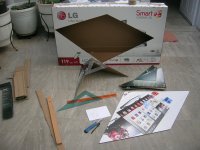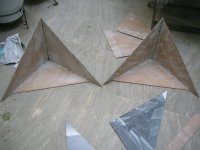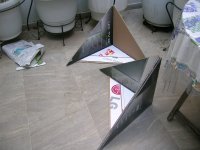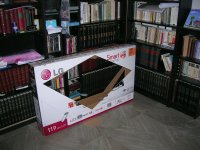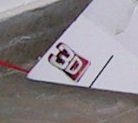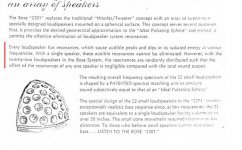I don't see any current research being audio oriented but there might be fallout in fast power devices (Class D?).
If I can find such power devices and get some... I'll throw them up on the curve tracer to see its potential for power OPS. Something to keep an eye out for.
THx-RNMarsh
J.C.
I finished a JC 3 preamp clone with my version of a power supply. Listening to it now. Sounds great.
Only TT in the shop is a Pioneer belt drive PL120 with proper lubrication and a new belt. Cartridge is a Stanton DJ model. Preamp and speakers are shown in AX. Power amp is modified from my very simple amp in AX.
Next version will be MC and use a Denon pick up. When I assemble that one I will measure each stage of the power supply as it is assembled for an article.
I finished a JC 3 preamp clone with my version of a power supply. Listening to it now. Sounds great.
Only TT in the shop is a Pioneer belt drive PL120 with proper lubrication and a new belt. Cartridge is a Stanton DJ model. Preamp and speakers are shown in AX. Power amp is modified from my very simple amp in AX.
Next version will be MC and use a Denon pick up. When I assemble that one I will measure each stage of the power supply as it is assembled for an article.
John, quality audio lives on the outskirts of the overall industry these days. Look for small, relatively or absolutely unknown manufacturers, chances are you'll find find some really good designs there.
Or, at least, music orientated, not specs orientated.
Or, at least, music orientated, not specs orientated.
John, quality audio lives on the outskirts of the overall industry these days. Look for small, relatively or absolutely unknown manufacturers, chances are you'll find find some really good designs there.
Or, at least, music orientated, not specs orientated.
Ah yes. I finished today my corner-coupled speakers. Carlson & graaf flooder mix.
Private audition on appointment.
😀😀
George
Attachments
Ah yes. I finished today my corner-coupled speakers. Carlson & graaf flooder mix.
Private audition on appointment.
😀😀
George
So that's what they call video speakers?
With drivers like these:Ah yes. I finished today my corner-coupled speakers. Carlson & graaf flooder mix.
Private audition on appointment.
😀😀
George
NewTec Design Audio - we converge sound with form
You could transcend the diffusers !
It was a self-sarcastic response to dvv post.
But the message is clear. The greatest benefits are to be gained by working on the acoustic problem (speaker-room integration).
🙂
George
But the message is clear. The greatest benefits are to be gained by working on the acoustic problem (speaker-room integration).
🙂
George
George,
I can remember not that long ago it was argued that corner placement of a speaker was one of the worst things you could do as it would excite room modes to an extreme. Now here we are using the corners for just that purpose.How times change our perceptions of acceptable room acoustics.
I can remember not that long ago it was argued that corner placement of a speaker was one of the worst things you could do as it would excite room modes to an extreme. Now here we are using the corners for just that purpose.How times change our perceptions of acceptable room acoustics.
No. Time does not change our perceptions of acceptable room acoustics.
It is that we have to fight on many fronts and so we have to weight things.
These corner speakers are 48db/oct high passed at 80Hz (the double woofer/sub is behind the tv).
Room mode excitation will not change a lot with shifting the small speakers 1m from the corner, as the wavelength of the room modes in this space is large.
There are some unique merits of such a corner speaker placement.
-No baffle step effect.
-Controllable reflections.
The three reflecting surfaces (two walls + floor) are 0.15-0.20m from any point of the speaker cone. Early reflections start 0.4-0.6ms delayed (that is in the region of any reflection occurring internally to a loudspeaker enclosure) and spread in time, closely separated due to the oblique angle of the walls (my experience with omnis tells me that closely spaced early reflections are not objectionable). If need arises, it is easy and aesthetically acceptable to cover the corner with material absorbing the 1kHz and above.
The fourth reflecting surface (roof) is quite away, producing >8ms delayed sprayed reflections.
-WAF (no useful space occupancy)
George
It is that we have to fight on many fronts and so we have to weight things.
These corner speakers are 48db/oct high passed at 80Hz (the double woofer/sub is behind the tv).
Room mode excitation will not change a lot with shifting the small speakers 1m from the corner, as the wavelength of the room modes in this space is large.
There are some unique merits of such a corner speaker placement.
-No baffle step effect.
-Controllable reflections.
The three reflecting surfaces (two walls + floor) are 0.15-0.20m from any point of the speaker cone. Early reflections start 0.4-0.6ms delayed (that is in the region of any reflection occurring internally to a loudspeaker enclosure) and spread in time, closely separated due to the oblique angle of the walls (my experience with omnis tells me that closely spaced early reflections are not objectionable). If need arises, it is easy and aesthetically acceptable to cover the corner with material absorbing the 1kHz and above.
The fourth reflecting surface (roof) is quite away, producing >8ms delayed sprayed reflections.
-WAF (no useful space occupancy)
George
Last edited:
George,
I can remember not that long ago it was argued that corner placement of a speaker was one of the worst things you could do as it would excite room modes to an extreme. Now here we are using the corners for just that purpose.How times change our perceptions of acceptable room acoustics.
Remember that's how Bose started? An octant of a sphere in the upper room corners, with multiple drivers on it. Later they decided that it sounded better turned around facing the wall. It probably did.
Isn't there a 3D wave tank java game somewhere where we can watch the wave bounce around the room?
George,
I can remember not that long ago it was argued that corner placement of a speaker was one of the worst things you could do as it would excite room modes to an extreme. Now here we are using the corners for just that purpose.How times change our perceptions of acceptable room acoustics.
Hey, I found the old Bose manual for their model 2201. It's a hoot.
http://products.bose.com/pdf/customer_service/owners/2201_guide.pdf
Hey, I found the old Bose manual for their model 2201. It's a hoot.
http://products.bose.com/pdf/customer_service/owners/2201_guide.pdf
I love the comment, to the effect that the resonances for all the drivers are different. Such quality control, it took an MIT Phd to figure it out. Then there's the Indian carvings, a cultural connection?
Last edited:
I wonder if those are the same 4" drivers that they used later in the 901? Fifty watts divided by 22 devices isn't much per unit, couple of watts each.
I love the comment, to the effect that the resonances for all the drivers are different. Such quality control, it took an MIT Phd to figure it out.
Scott
You are talking about the low resonant frequency of each speaker unit and the spread of it in a production line, yes?
I would expect a more clear explanation in the brochure.
IMO, the sentence may mean peaks and dips of acoustic energy caused by resonances due to driver-room-sensor placement. When there are multiple drivers –even closely spaced-these dips and peaks due to resonances (*) and reflections tend to smooth-out.
George
(*) one can argue that there are other dips and peaks generated with this arrangement, acoustic comb.
Yes but we have to be careful, as acoustic comb filtering happens with every wide freq range loudspeaker construction.
It is also present within the cone of a single wide range driver. We can’t escape that reality.
Attachments
I wonder if those are the same 4" drivers that they used later in the 901? Fifty watts divided by 22 devices isn't much per unit, couple of watts each.
Plus, you get the 3dB efficiency bonus you have from any doubling of the number of drivers.
So let´s say these little critters are 82dB/W efficient each, take 22 of them working as coincident drivers, and the total system efficiency goes up to about 95dB/W.
Of course this falls apart at higher frequencies, since the drivers are no longer coincident, but this is where the equalization comes in.
One of the great contributions of Dr, Bose to loudspeaker design is that he realized that the loudspeaker system does not have to be linear, as long as you can correct these non-linearities through electronic means. That provides you with an extra degree of design freedom.
Also, running 22 speakers at low(er) cone excursions would translate into lower distortion.
I heard the 901s back in the late 70 's IIRC against the big AR's of the time.
I did not know much about sound, but I felt they both sounded terrible. B & T were there but image wise the whole thing was just a wall of sound. And the sales guy insisted on playing loud rock music. They were using one of the Marantz amps of the time.
Thankfully we have progressed.
A year or two later I heard Dahlqvists (spelling?) driven by a Phase Linear set up. An altogether better proposition.
I heard the 901s back in the late 70 's IIRC against the big AR's of the time.
I did not know much about sound, but I felt they both sounded terrible. B & T were there but image wise the whole thing was just a wall of sound. And the sales guy insisted on playing loud rock music. They were using one of the Marantz amps of the time.
Thankfully we have progressed.
A year or two later I heard Dahlqvists (spelling?) driven by a Phase Linear set up. An altogether better proposition.
Last edited:
Bonsai,
No matter how you look at it trying to run a small 4" cone driver full range is going to have a very limited bandwidth, you can never make a full range speaker that will cover the entire range satisfactorily. So add all the number of devices together you want you still never get to a great level of sound quality. I remember the early 901 series and I was not a fan of those or any other of Bose products, they are adequate only for those who do not listen critically to music.but have those for background sound. I will never say that Bose does not do it research or that they do not understand their market, just that I do not consider any of their products acceptable for my music listening pleasure. Perhaps if I spent long hours on planes or in noise environments i would appreciate their noise cancellation headphones, but I think that is where I would draw the line.
No matter how you look at it trying to run a small 4" cone driver full range is going to have a very limited bandwidth, you can never make a full range speaker that will cover the entire range satisfactorily. So add all the number of devices together you want you still never get to a great level of sound quality. I remember the early 901 series and I was not a fan of those or any other of Bose products, they are adequate only for those who do not listen critically to music.but have those for background sound. I will never say that Bose does not do it research or that they do not understand their market, just that I do not consider any of their products acceptable for my music listening pleasure. Perhaps if I spent long hours on planes or in noise environments i would appreciate their noise cancellation headphones, but I think that is where I would draw the line.
- Status
- Not open for further replies.
- Home
- Member Areas
- The Lounge
- John Curl's Blowtorch preamplifier part II
